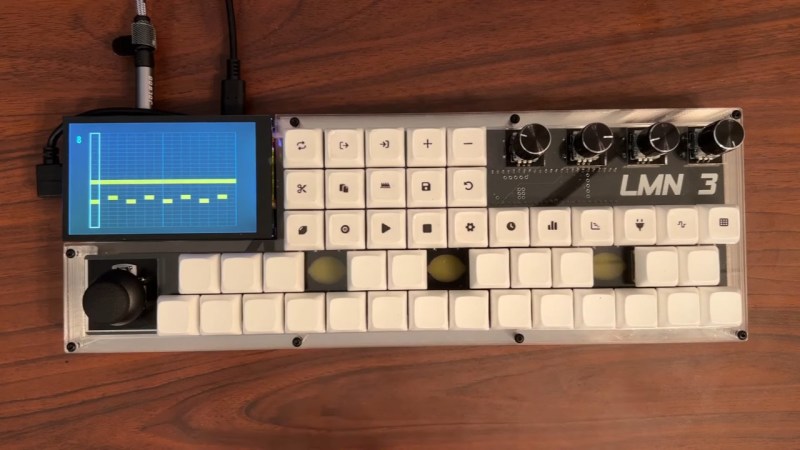Some projects you come across simply leave you in awe when you look at the thought and the resulting amount of work that went into it, not only for the actual implementation, but everything around it. Even more so when it’s a single-developer open source project. [Stone Preston]’s synth / sampler / sequencer / DAW-in-a-box LMN-3 absolutely fits the description here, and it seems like he has set his heart on making sure everyone can built one for themselves, by providing all the design files from case down to the keycaps.
The LMN-3 (LMN as in “lemon”, not “comes before the OP“) is intended as a standalone, portable digital audio workstation, and is built around a Raspberry Pi 4 with a HyperPixel display for the user interface. The UI itself, and with it the core part of the software, was created using the Tracktion Engine, which itself uses the JUCE framework and combines your typical synthesizer, sequencer, and sampler features with the DAW part to handle recording, editing, and mixing. The remaining hardware is a custom-designed PCB with a set of function and keyboard buttons, along with a pitch bend joystick and four rotary encoders with push buttons that serve as main input handlers. Oh yes, and a Teensy board.
The UI is actually entirely controlled via MIDI commands, and custom firmware on the Teensy is translating the input events from buttons, encoders, and joystick accordingly. This essentially decouples the hardware from the software, and using a cross-platform framework underneath, you can also run the UI standalone on your computer and use any 3rd-party MIDI controller you like. Or then, as [Stone] thought really about everything, use a hardware emulator he created in addition. You could even leave out the Raspberry Pi and software altogether and turn this into a pure MIDI controller. If that sounds tempting, but you’re looking for something with more knobs and sliders instead of buttons, check out the Traktorino. And if you actually prefer a mouse as input device, there’s always something running in a browser.















Wait, that’s gorgeous! I have always wanted to build something like that, but never found the moment. Congrats!
Awesome :-)
This is GREAT! Very Resourceful! I built my own synth when I was 13 years old… I’m 62 now- maybe it’s time to build another one!Ha!
Amazing project, though considering how otherwise polished it is I’m a bit disappointed by the exposed USB cable for internal signal routing. Also, aren’t proper RPis still hard to come by? I would think the zero or some cheaper clone would be a better fit for an embedded project like this
Might be nice to run sonething like Sonic Pi on board with this; I like the flexibility of a full “relatively powerful” computer in the synth.
Wow, that’s an amazing accomplishment, nicely done and thanks for sharing!!
The one thing I’d consider for the next incarnation: If you added a low E and a high F to the keyboard, you’d have 16 keys across the bottom for X0X style sequence entry (like my trusty RS7000, among others).
This is really nice
Jeremy from Red Means Recording should be able to play with one
Man, this have so many functions it should come with a 200 page manual. Hard-copy, not PDF, and on those spiral bonded manuals from IBM.
I wish I had enough time, skills, dedication and creativity to do something like that! Truly neat!
I look forward to the Kickstarter.